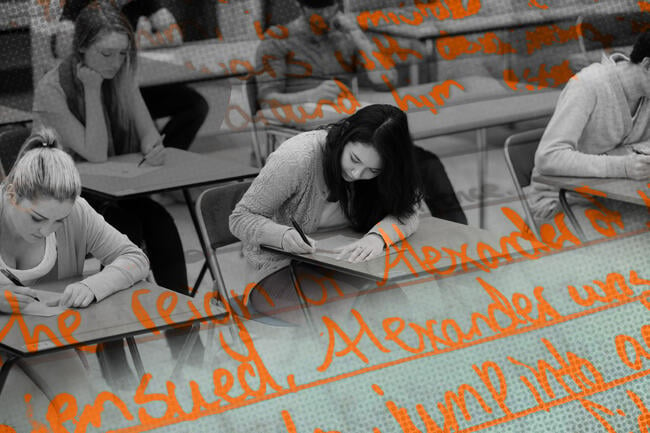You have /5 articles left.
Sign up for a free account or log in.

Monica Sain has asked students to do some analog work in class since shortly after ChatGPT debuted, but now she is asking students to write their essays in class, too.
Photo illustration by Justin Morrison/Inside Higher Ed | History Skills and Wavebreakmedia/iStock/Getty Images
In Melissa Ryckman’s world history survey, an introductory class that consists mostly of non–history majors, she asks her students to complete a brief 100-word assignment every Friday based on what they learned over the previous week. The questions are not based on rote memorization but rather ask students to think critically about the material, exploring, for example, whether they would rather be hunter-gatherers or farmers. It’s an attempt to get students both to engage with the lessons—and to avoid ChatGPT.
Ryckman, an associate professor at the University of Tennessee Southern, said she figured students might actually want to share their own opinions rather than rely on the generative AI tool that has become the bane of many educators. But she found that students still submitted AI-written answers.
So now, Ryckman is switching things up. Starting next semester, she’s planning to have her students write their responses in class to deter the use of AI—and she’s even considering requiring them to write the answers out by hand.
“I’m leaning towards that, but I’m also like—ugh, handwriting,” she said. “I might have them do them online in front of me … but it’s just so much policing.”
Ryckman is one of many professors who are weighing a shift back to handwritten assignments in the hopes of preventing students from copying and pasting their work from ChatGPT and other generative AI tools, which students are increasingly using to complete their schoolwork. In a Reddit post about faculty moving to handwritten assignments, dozens of professors said they now require at least some assignments to be handwritten, while a small number said all the writing in their class is done by hand.
Even blue books are back in vogue; The Wall Street Journal reported in late May that sales of the once-ubiquitous exam booklets have been on the rise at institutions like Texas A&M University and University of California, Berkeley, in recent years.
At the same time, others have raised concerns about the return to handwriting. How do you accommodate students with disabilities that require them to use technology? How do you account for the fact that handwriting takes longer than typing? What if students refuse to handwrite assignments—or express their displeasure with the requirement in course evaluations? Most ominously, what if the technique doesn’t fix the problem and students simply transcribe responses produced by ChatGPT?
Tricia Bertram Gallant, a scholar of academic integrity and the author of The Opposite of Cheating: Teaching for Integrity in the Age of AI (University of Oklahoma Press, 2025), stressed the importance of finding secure solutions for evaluating student performance as ChatGPT’s popularity rises—including handwritten exams and assignments.
“We’re not just in the business of facilitating learning; we’re in the business of certifying learning. There has to be secure assessments to say to the world, ‘This is a person who has the knowledge and abilities we are promising they have,’” she said.
‘Rotten Tomatoes’
Handwriting is just one in a long line of strategies professors have deployed in trying to curb unauthorized student use of generative AI tools, from attempting to create assignments that AI can’t answer, to learning the tells of an AI-generated paper, to simply trying to help students appreciate the value of doing their own work.
As the technology has grown more ubiquitous, faculty have found it increasingly difficult to combat the rise of AI cheating; it’s hard to counter the argument that students will likely use AI in their future careers so professors should be leaning into ChatGPT—teaching how to use the tool, or at least allowing their students to experiment with its use in assignments—rather than shying away.
“We’re sometimes pushed to incorporate high-tech tools in our classroom, and this can be difficult to resist, especially if a professor is not tenured or they’re an adjunct,” said Sara Gallagher, a professor at Durham College in Ontario, Canada. “In my college that I’m teaching in right now, we had a whole seminar that was mandatory that we attended that was very pro generative AI, and I remember thinking after the session, ‘There’s no way for me as a professor to tell if someone’s cheating,’ because [the seminar] really didn’t answer that question.”
But many of the professors now relying on handwritten work—much of it completed in class—say they’ve seen significant changes, not only in the quality of the students’ work, but also in their attitudes toward their education more broadly.
Monica Sain, who teaches English at Mission College, a community college in California, first began inching away from tech in her classroom shortly after ChatGPT came on the scene in late 2022. She soon asked students in her English composition courses to begin highlighting and annotating the assigned readings, just to prove they weren’t relying on ChatGPT summaries. Later, when she noticed students asking AI for help during in-class discussions, she prohibited laptops and phones from being used in her classroom. She calls it a “digital detox.”
But recently, she’s begun taking even more drastic measures. Students are now required to complete their midterm assignment, an argumentative essay, by hand in class—a process that takes several class periods to complete.
At first, students were terrified of the prospect of writing an entire essay in class.
“When I first told them, I was like, ‘OK, guys, don’t throw rotten tomatoes at me,’” she said. “Some people looked at me, like, ‘Oh God, are you kidding?’ Some people looked kind of scared, and some people’s faces fell. And I almost felt like, ‘Oh, I don’t want to do this to them. I don’t want to traumatize them or something.’”
But she worked to ensure the assignment was as fair to the students as possible, giving them ample time to prepare and allowing them to bring their sources and other materials to class with them—printed out on paper, of course. She also provided a cheat sheet, of sorts, that outlines the requirements of the essay, like the thesis statement and a counterargument.
“After they got it done, the students were like, ‘Oh, that wasn’t so bad,’” she said. “The good thing is, some students told me they preferred handwriting—I was really surprised—because they said they felt distracted a lot of the times that they did it on the computer. They said it would be so tempting to answer one little thing on social media or look at some video really quickly.”
She faced some hurdles, she said; the first time she ran the assignment, in fall 2024, some students forgot to bring in their printed materials. But she found an easy solution in the spring, requiring students to bring in the printed materials the day before the test to provide some buffer.
Gallagher had a similar experience after she began requiring students to handwrite their essays in class and increased the weight of attendance on students’ grades for her courses this summer.
“When students are using ChatGPT and using a lot of digital tools like ChatGPT to do the work, they become disengaged from the work and they just stop caring—which, I kind of can’t blame them,” she said. “One thing I’ve noticed is that that engagement is back. The wanting to ask questions, the wanting to learn, even coming up to me after class and having a discussion about what we talked about. That’s something that disappeared in my classroom for up to a year, and I was worried—is it something I’m doing?”
Gallagher still requires students to do some homework, including assignments with elements like infographics, which Gallagher thinks are harder for ChatGPT to produce. For other assignments, such as an annotated bibliography, students are allowed to use their laptops but must complete the assignment in class so she can observe their processes and the tools they use.
But the handwritten work seems to have made an outsize impact. Not only are students more engaged with the material, but Gallagher also said they are talking and connecting with each other more than any of her other classes over the past several years, whose students had spent their formative high school years in virtual classrooms during COVID-19.
“It’s kind of reintroducing them, in some ways, to what the classroom was a decade ago,” she said. “The classroom was a space for learning, but it’s also a space for connecting, and I noticed the students are very receptive to that.”
Gallant said that flipped classrooms—the model in which students learn the material outside class, via lecture videos and other materials, and complete tasks and assignments in class—seems to be one of the most effective ways to ensure assessments are secure.
“People are starting to realize that we are no longer in the business of delivering information and knowledge and content; we are in the business of facilitating human-to-human learning environments,” she said. “It could be writing in class, as a flipped classroom activity. Writing is so hard, right? So why do we make novice writers do it alone and do it in isolation when we could do it with them and provide coaching in the moment?”
Finding Balance
Gallagher and Sain have run into some of the feared hurdles of handwritten assignments. Chicken scratch can be an issue, Sain said, but most of her students, surprisingly, have better handwriting than she expected. Gallagher said that her skills deciphering bad penmanship have improved dramatically since the beginning of the semester.
Sain said she has made it clear that students with disabilities who need to take notes with technology are welcome to do so even in her digitally detoxed classroom, but few have taken her up on the option, save one student who used a tablet. Those who need more time or other accommodations on their essays are allowed to take them in the disability services office with a proctor.
But for all that’s gained from low-tech assignments, some things are still lost. For Gallagher, for example, it can feel like some elements of the writing and research process are impossible to impart when essays are written entirely in class.
“Part of the benefit of writing a long-form text or writing an essay was it gave kind of a perfect assignment for teaching students how to do the research process, where to find good sources,” she said.
She still teaches these skills, but now they culminate in a final presentation—itself at least somewhat ChatGPT-proofed by the fact that students have to answer questions and explain their thinking on the fly.
Some professors on social media also expressed concerns about how to find time to adapt their essays and other writing assignments to work that’s handwritten in class. Gallant, the academic integrity researcher, said it should fall on institutions, not professors, to create time for faculty to make those adjustments, as well as to provide training and the assistance of institutional designers to help them ChatGPT-proof their courses.
As Ryckman, the UT Southern professor, considers just how much of her syllabus to switch from at-home, digital assignments to in-person and potentially handwritten, her main question is how she will balance that work with in-class lectures and discussion.
“I don’t know that doing an annotated bibliography in class is going to be possible without sacrificing a bunch of stuff,” she said. “That balance is going to be tough, I think.”





